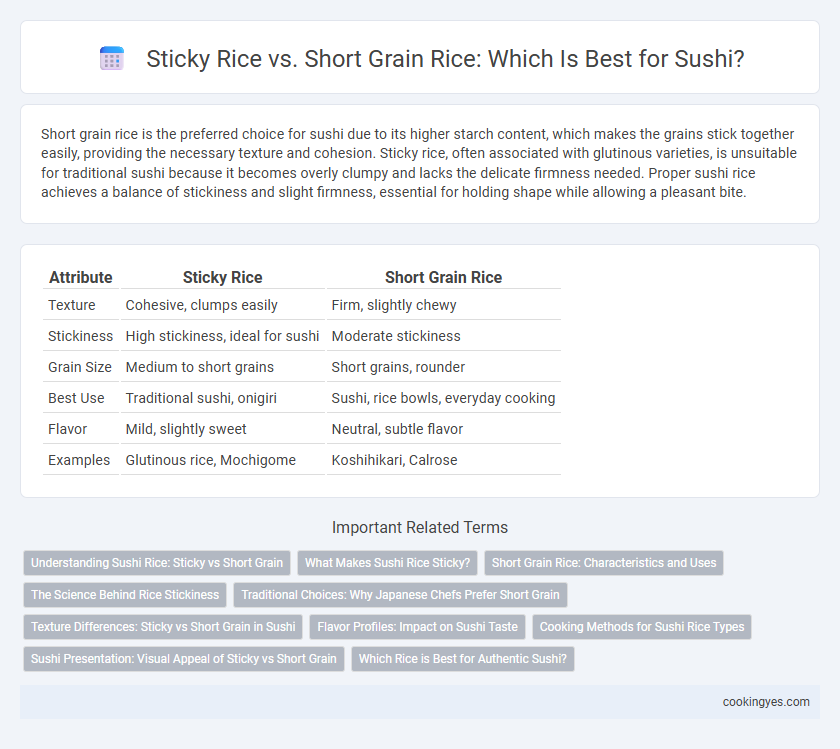Short grain rice is the preferred choice for sushi due to its higher starch content, which makes the grains stick together easily, providing the necessary texture and cohesion. Sticky rice, often associated with glutinous varieties, is unsuitable for traditional sushi because it becomes overly clumpy and lacks the delicate firmness needed. Proper sushi rice achieves a balance of stickiness and slight firmness, essential for holding shape while allowing a pleasant bite.
Table of Comparison
| Attribute | Sticky Rice | Short Grain Rice |
|---|---|---|
| Texture | Cohesive, clumps easily | Firm, slightly chewy |
| Stickiness | High stickiness, ideal for sushi | Moderate stickiness |
| Grain Size | Medium to short grains | Short grains, rounder |
| Best Use | Traditional sushi, onigiri | Sushi, rice bowls, everyday cooking |
| Flavor | Mild, slightly sweet | Neutral, subtle flavor |
| Examples | Glutinous rice, Mochigome | Koshihikari, Calrose |
Understanding Sushi Rice: Sticky vs Short Grain
Sushi rice is best made from short grain rice, which naturally contains higher amylopectin levels, giving it the sticky texture essential for sushi. Sticky rice acts as a cohesive binder, allowing sushi to hold its shape without falling apart during handling or eating. Choosing authentic Japanese short grain rice enhances flavor and texture, key components in traditional sushi preparation.
What Makes Sushi Rice Sticky?
Sushi rice becomes sticky due to its high amylopectin content, a type of starch that gelatinizes and binds grains together during cooking. Short-grain rice is preferred for sushi because its naturally higher amylopectin concentration provides the perfect adhesive texture essential for shaping sushi. Proper washing and precise water-to-rice ratios also enhance the rice's stickiness, ensuring it holds firmly without becoming mushy.
Short Grain Rice: Characteristics and Uses
Short grain rice is prized for its high starch content, which gives it a plump, slightly sticky texture ideal for sushi. Its moisture retention and tenderness make it perfect for molding and holding together in sushi rolls and nigiri. Common varieties used for sushi include Koshihikari and Calrose, valued for their balance of stickiness and subtle sweetness.
The Science Behind Rice Stickiness
Sticky rice, or glutinous rice, contains a higher proportion of amylopectin, a branched starch molecule responsible for its characteristic adhesion, essential for sushi's cohesive texture. Short grain rice has a balanced amylose to amylopectin ratio, providing enough stickiness to hold sushi ingredients together while maintaining a tender bite. The molecular structure of starch granules in short grain rice gelatinizes at specific temperatures, releasing amylopectin that enhances stickiness without the overly gummy texture typical of glutinous rice.
Traditional Choices: Why Japanese Chefs Prefer Short Grain
Japanese chefs prefer short grain rice for sushi due to its ideal balance of stickiness and texture, which ensures the rice clings together without becoming mushy. The high amylopectin content in short grain rice creates a slightly sticky consistency crucial for forming sushi rolls and nigiri. Traditional sushi preparation relies on this specific rice variety to achieve authentic flavor and mouthfeel, distinguishing it from other types like sticky rice used in non-Japanese cuisines.
Texture Differences: Sticky vs Short Grain in Sushi
Sticky rice used in sushi typically has a higher amylopectin content, resulting in a clumpier and more adhesive texture that helps the rice hold together when shaped. Short grain rice, while also sticky, often has a slightly firmer bite and less overall stickiness, providing a balanced texture that supports the fish without overpowering it. The choice between sticky and short grain rice influences the mouthfeel and presentation of sushi, making texture a critical factor in sushi preparation.
Flavor Profiles: Impact on Sushi Taste
Sticky rice, also known as glutinous rice, offers a sweet, delicate flavor and chewy texture that enhances the overall sushi experience by binding ingredients seamlessly. Short grain rice, while less sticky, has a slightly nutty and mild taste that allows the freshness of fish and other toppings to shine through. The choice between these rice types significantly influences sushi's balance of texture and flavor, impacting the dish's authenticity and enjoyment.
Cooking Methods for Sushi Rice Types
Sticky rice requires careful rinsing and soaking to achieve the perfect texture, followed by precise steaming to retain its moisture and stickiness essential for sushi. Short grain rice, often preferred for sushi, is cooked using a gentle simmering method with a measured amount of water, allowing the grains to absorb moisture evenly and become tender yet firm. Proper seasoning with rice vinegar, sugar, and salt is crucial after cooking to enhance flavor and achieve the characteristic glossy finish of traditional sushi rice.
Sushi Presentation: Visual Appeal of Sticky vs Short Grain
Sticky rice enhances sushi presentation by creating compact, glossy rice balls that hold their shape and highlight vibrant toppings, ensuring a visually appealing dish. Short grain rice, while slightly less sticky, provides a firm texture and rounder grain appearance, resulting in a more delicate and refined sushi look. Chefs prioritize sticky rice for its ability to contrast colors and elevate the overall aesthetic of traditional nigiri and maki rolls.
Which Rice is Best for Authentic Sushi?
Short grain rice is best for authentic sushi due to its high starch content, which creates the ideal sticky texture needed to hold sushi ingredients together. Sticky rice, often associated with glutinous varieties, is too dense and chewy, making it less suitable for traditional sushi preparations. Using genuine short grain sushi rice ensures the perfect balance of firmness and stickiness essential for classic sushi rolls and nigiri.
Sticky vs Short Grain for Sushi Infographic

 cookingyes.com
cookingyes.com